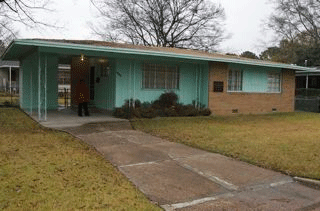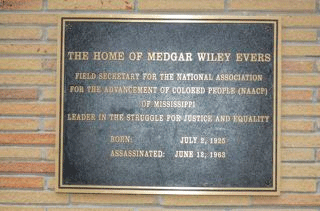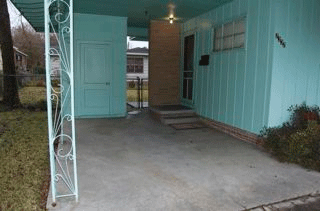 We pulled into Jackson very late last night. On the bus en route, we watched “Ghosts of Mississippi,” a movie that tells the story of the 1994 prosecution and ultimate conviction of Byron de la Beckwith for the assassination of Medgar Evers, the field secretary for the Mississipi NAACP. Evers’ courageous stand against Jim Crow laws had placed him in harm’s path for years – it was Evers who, in 1955, travelled to Money, Mississippi to investigate the lynching of 14 year old Emmitt Till. In 1963, he was gunned down in the driveway of his Jackson home while his wife and three children waited up for him inside. We had studied Evers in class, but few of the students knew the story of the trial and conviction of his assassin, and the film set the stage for our visit to the Evers’ modest house. Evers’ widow, Myrlie Evers Williams, donated the house to Tougaloo College, and it has since been turned into a museum. The curator from Tougaloo told us that Ms. Evers Williams had to sell most of their possessions to move to California after the murder, so the furnishings in the house are period but not original. The concrete in the driveway still bears faint blood stains that trace the path Medgar Evers crawled after he was shot.
We pulled into Jackson very late last night. On the bus en route, we watched “Ghosts of Mississippi,” a movie that tells the story of the 1994 prosecution and ultimate conviction of Byron de la Beckwith for the assassination of Medgar Evers, the field secretary for the Mississipi NAACP. Evers’ courageous stand against Jim Crow laws had placed him in harm’s path for years – it was Evers who, in 1955, travelled to Money, Mississippi to investigate the lynching of 14 year old Emmitt Till. In 1963, he was gunned down in the driveway of his Jackson home while his wife and three children waited up for him inside. We had studied Evers in class, but few of the students knew the story of the trial and conviction of his assassin, and the film set the stage for our visit to the Evers’ modest house. Evers’ widow, Myrlie Evers Williams, donated the house to Tougaloo College, and it has since been turned into a museum. The curator from Tougaloo told us that Ms. Evers Williams had to sell most of their possessions to move to California after the murder, so the furnishings in the house are period but not original. The concrete in the driveway still bears faint blood stains that trace the path Medgar Evers crawled after he was shot.
Student Responses:
Peter: Jackson, Mississippi. I’ll be honest; I’ve been more comfortable in my life. As an African-American from the north, I can say that I felt a little uneasy in the presence of Mississippi, a state that is known for its ugly and often violent race relations, especially in the mid-twentieth century. So, that being said, today we visited the home of Civil Rights worker Medgar Evers, the same place where he was also assassinated. The house itself was an ordinary house, designed to look like it did back in the 1950’s and 60’s. Getting a tour of the house was quite interesting. We got to see how in the room where Medgar Evers’ children slept, the beds were on the floor because the family was afraid that the children would get shot with a stray bullet. To me that made the experience more real, because we got to see first hand the real danger that not just the crusaders for equality were in, but their families as well. These individuals risked everything, including family for the betterment of the U.S. and many, including Medgar Evers paid the ultimate price. Evers was slain in his driveway as he returned home. He was shot in the back while his family was in the house. It was still possible to see where his blood had been spilled because the stains in the cement were still visible some 50 years later. That was unbelievable to me that the stains were still so visible after so long. It really dawned on me that these Civil Rights workers and leaders lived in the battlefield. They were in an environment where they could be tormented and even murdered, and even worse, they called it home. These people risked their lives everyday so that our generation can live better, and I truly feel that if my generation embraces this ethos, we have a tremendous opportunity to make a great change for the better in our lifetimes.



